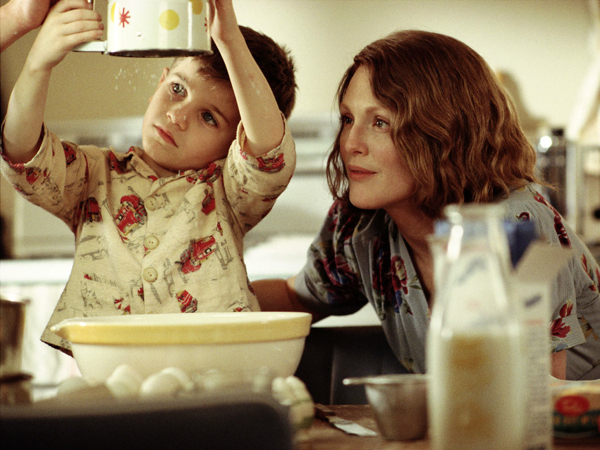Movie review by Greg Carlson
At its best, Stephen Daldry’s screen version of Michael Cunningham’s Pulitzer Prize-winning novel “The Hours” is a cinematic tour de force – a delicately handled meditation on those elusive, solitary Woolf-ian intelligences that resist even adequate treatment in the cinematic format. At its worst, the movie is an operatic muddle – an occasionally hoarse disarray of an actor’s showcase, providing more than the usual supply of opportunities to set fire to the scenery. The intersections of madness and genius are perennial catnip to the givers of awards (see the ridiculous, already dated “A Beautiful Mind”), and on that count, “The Hours” is sufficiently mobilized.
Operating as a shored-up triptych that doesn’t always gel, the film covers three women in three time periods: uber-writer Virginia Woolf (Nicole Kidman and prosthetic nose) in 1923 composing “Mrs. Dalloway” while fighting off the demons of her mind, suburban housewife Laura Brown (Julianne Moore) in 1951 finding her own fragile hold on marriage and motherhood coming unglued even as her life is transformed by reading “Mrs. Dalloway,” and Clarissa Vaughan (Meryl Streep) in 2001 loosely acting out the part of a modern day Mrs. Dalloway as she prepares for a party to honor her former lover, a poet now dying of complications from AIDS.
The agenda of “The Hours” is decidedly grim, and Daldry meets the challenge head-on with an opening set piece that imagines Woolf’s suicide by self-drowning in March of 1941 as a languid, romanticized Pre-Raphaelite painting. Weighed down with stones in the pockets of her coat, Woolf’s submergence is attended with thanatological fervor: gliding along underwater, her shoe comes loose in a fetishized tableau that would do John William Waterhouse proud. Taking one’s own life is firmly established as a central motif, and the succeeding stories will attend to the sad topic in ways both expected and surprising.
While Kidman (false proboscis and all) excels at capturing subtlety and nuance in her handling of a difficult role (witness, for example, an exquisite, heartbreaking train station scene between Virginia and husband Leonard, played by Stephen Dillane) and Streep is as peerless as ever, Julianne Moore’s segments are easily the film’s most troublesome. For some reason, Daldry chooses the 1951 setting as a staging ground for the most artificial and extravagantly over-designed theatrics of the movie, and despite Moore’s noble efforts, too much information is missing to connect all the dots. With the exception of a few quotations of Woolf’s, screenwriter David Hare has done away with voiceover – an admirable choice that proves a hindrance in at least this portion.
The supporting cast is almost uniformly impressive, featuring some memorable work by Ed Harris (who takes it a little too far a little too often) as Clarissa’s former lover, Jeff Daniels (in what amounts to an extended cameo), Claire Danes as Clarissa’s daughter, and Allison Janney as Clarissa’s partner. Moore is assisted by her old colleague John C. Reilly, whose presence always makes even the best-staffed films more interesting, as well as Toni Collette, in what has to be the movie’s oddest diversion. Besides the terrific Dillane, Kidman’s scenes are fleshed out by the presence of Miranda Richardson as Woolf’s sister Vanessa Bell. The movie remains firmly in the grip of its three leads, however, and audiences looking for a fearless plunge into the heart’s darkest reaches should be pleased by the results.
